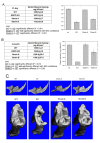DSPP dosage affects tooth development and dentin mineralization
- PMID: 34038418
- PMCID: PMC8153449
- DOI: 10.1371/journal.pone.0250429
DSPP dosage affects tooth development and dentin mineralization
Abstract
Dentin Sialoprotein (DSP) and phosphophoryn (PP) are two most dominant non-collagenous proteins in dentin, which are the cleavage products of the DSPP (dentin sialophosphoprotein) precursor protein. The absence of the DSPP gene in DSPP knock-out (KO) mice results in characteristics that are consistent with dentinogenesis imperfecta type III in humans. Symptoms include thin dentin, bigger pulp chamber with frequent pulp exposure as well as abnormal epithelial-mesenchymal interactions, and the appearance of chondrocyte-like cells in dental pulp. To better understand how DSPP influences tooth development and dentin formation, we used a bacterial artificial chromosome transgene construct (BAC-DSPP) that contained the complete DSPP gene and promoter to generate BAC-DSPP transgenic mice directly in a mouse DSPP KO background. Two BAC-DSPP transgenic mouse strains were generated and characterized. DSPP mRNA expression in BAC-DSPP Strain A incisors was similar to that from wild-type (wt) mice. DSPP mRNA expression in BAC-DSPP Strain B animals was only 10% that of wt mice. PP protein content in Strain A incisors was 25% of that found in wt mice, which was sufficient to completely rescue the DSPP KO defect in mineral density, since microCT dentin mineral density analysis in 21-day postnatal animal molars showed essentially identical mineral density in both strain A and wt mice. Strain B mouse incisors, with 5% PP expression, only partially rescued the DSPP KO defect in mineral density, as microCT scans of 21-day postnatal animal molars indicated a reduced dentin mineral density compared to wt mice, though the mineral density was still increased over that of DSPP KO. Furthermore, our findings showed that DSPP dosage in Strain A was sufficient to rescue the DSPP KO defect in terms of epithelial-mesenchymal interactions, odontoblast lineage maintenance, along with normal dentin thickness and normal mineral density while DSPP gene dosage in Strain B only partially rescued the aforementioned DSPP KO defect.
Conflict of interest statement
The authors have declared that no competing interests exist.
Figures







References
-
- Sreenath TL, Thyagarajan T, Hall B, Longenecker G, D’Souza RN, Hong S, et al.. Dentin sialophosphoprotein knockout mouse teeth display widened predentin zone and develop defective dentin mineralization similar to human dentiogenesis imperfecta type III. Journal of Biological Chemistry. 2003;278:24874–80. - PubMed
Publication types
MeSH terms
Substances
Grants and funding
LinkOut - more resources
Full Text Sources
Other Literature Sources
Molecular Biology Databases
Research Materials
Miscellaneous

